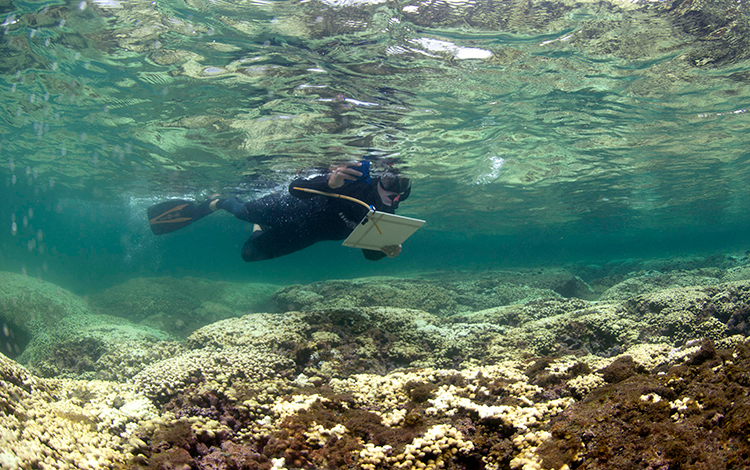- ABOUT US
- PROGRAM AREAS
- CONSERVATION APPROACH
- EDUCATION
- MULTIMEDIA
From Coral Bleaching to Signs of Recovery in Hawaii

Last fall, warmer-than-average ocean temperatures resulted in a serious coral bleaching event in Hawaii. Marine resource managers and scientists immediately took to the water to monitor and document the effects of this phenomenon on local coral reef communities. What they've seen is that over time, many of the bleached corals they monitored are showing signs of recovery.
Anne Rosinski, a marine resource specialist at the Hawaii Division of Aquatic Resources, was one of the state's first responders. Her job was to organize the division's initial assessment of the event, coordinate with partners, and ensure that the public received the latest information on the bleaching.
With news that current ocean conditions may trigger more bleaching in the coming months, Rosinski shares how many of Hawaii's coral reefs are beginning to bounce back following last year's bleaching event.
Please tell everyone about the 2014 bleaching event in Hawaii.
In late September and early October 2014, Hawaii experienced a huge spike in ocean temperatures and a period of very low winds. Our divers were logging in-water temperatures of 86°F during this time. This was dangerously warm for corals and we started to see dramatic coral bleaching across the state.
Although we did see bleaching from Kauai to Hawaii Island, the worst bleaching seems to be across the windward side of Oahu, which includes the coral reefs of Kaneohe Bay. In Kaneohe Bay, our Rapid Response Team noted that about 80 percent of the dominant corals were bleached white.
There are reports that some corals that bleached have recovered or are recovering. Can you tell us more about that?
Yes, since October the temperatures have returned to a normal range. Just in the past few weeks, our team has observed color returning to the bleached corals, which shows us that they are beginning to recover. Although we did see re-coloring in around 90 percent of the colonies we tagged, we also did see some dead coral and coral that is still bleached.
Also, as recently as a week ago Division of Aquatic Resources team members found a severe outbreak of acute Montipora White Syndrome, a damaging coral disease that is affecting Montipora corals in Kaneohe Bay. Bleaching events like the one we had last year make corals more susceptible to diseases, so we're definitely still very concerned.
How do corals recover from bleaching?
Corals take a long time to recover from bleaching. Even though we're encouraged by seeing the color returning, these corals have a long road ahead of them until we would consider them fully "recovered".
How does the NOAA coral reef science community support your management needs when a bleaching event occurs?
The first indication we had that we could be seeing severe bleaching throughout the Hawaiian Archipelago was through the NOAA Coral Reef Watch program and web site. These invaluable tools helped us to understand what was happening to our corals and what we could predict to happen in the future. Seeing the forecasts generated by this system was especially helpful to us in planning monitoring and assessment activities and communicating this information to the public.
News of mass bleaching events may, understandably, leave some people with the impression that the situation is beyond repair or hope. Can the signs of coral recovery in Hawaii give people hope for reefs across the globe?
It's amazing to see corals coming back from such an extreme temperature event like we had in Hawaii in 2014. With a coral disease now affecting some of the bleached area and bleaching events predicted to happen more frequently, it's worrisome how much our corals can take.
I think the hope we can offer is that we will continue to work to understand exactly how these events are affecting our coral reefs and we hope that our restoration activities will give corals the best possible chance of surviving and supporting this critically important ecosystem.
For more information on Hawaii's continued response to the 2014 bleaching event, as well as the latest videos and photos, visit : dlnr.hawaii.gov/reefresponse.
About Us

The NOAA Coral Reef Conservation Program was established in 2000 by the Coral Reef Conservation Act. Headquartered in Silver Spring, Maryland, the program is part of NOAA's Office for Coastal Management.

The Coral Reef Information System (CoRIS) is the program's information portal that provides access to NOAA coral reef data and products.
Work With US
U.S. Coral Reef Task Force
Funding Opportunities
Employment
Fellowship Program
Contracting Assistance
Graphic Identifier
Featured Stories Archive

Access the archive of featured stories here...
Feedback
Thank you for visiting NOAA’s Coral Reef Conservation Program online. Please take our website satisfaction survey. We welcome your ideas, comments, and feedback. Questions? Email coralreef@noaa.gov.
Stay Connected
Contact Us
NOAA’s Coral Reef Conservation Program
SSMC4, 10th Floor
1305 East West Highway
Silver Spring, MD 20910
coralreef@noaa.gov
